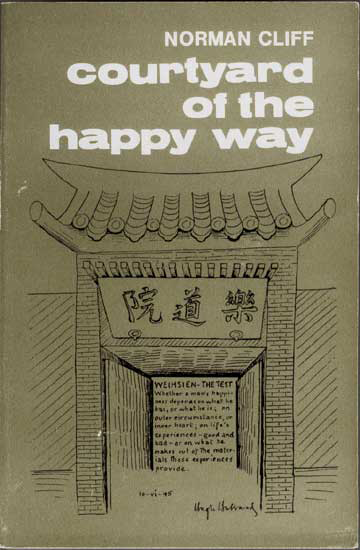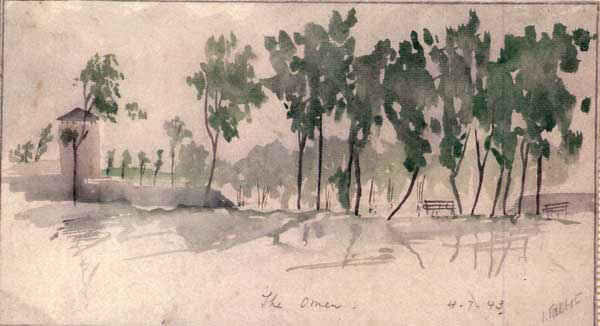
- by Norman Cliff
[excerpts] ...
[...]
by Mary E. Scott
http://www.weihsien-paintings.org/books/KeptInSafeguard-MaryScott/MaryScott(web).pdf
 Coal dust was issued according to the size of the stove: one bucket for a small stove, two buckets for a medium-sized one, and three buckets for a large stove. No lump coal was issued. The dust had to be mixed with clay and water to form coal balls or bricks. (The men exchanged coal-ball “recipes”: three of dust to one of clay, or four to one.)
Coal dust was issued according to the size of the stove: one bucket for a small stove, two buckets for a medium-sized one, and three buckets for a large stove. No lump coal was issued. The dust had to be mixed with clay and water to form coal balls or bricks. (The men exchanged coal-ball “recipes”: three of dust to one of clay, or four to one.)
I made as many as 500 to 800 coal balls in one day and set them aside to dry. Though not exactly the most convenient way to get heat, we were grateful for coal dust we were given, especially since many times we had to break the ice in the water bucket to wash our faces and hands in the morning.
[excerpt]
With such a cross section of humanity from all walks of life, from the highest executive of a large mining or tobacco company, missionaries, professors, artists, and importers, to junkies and women of the street, it was inevitable that there would be some conflict—in thought at least. In normal city missionary life, the business community and the missionaries moved in different circles and saw very little of each other.
But in camp, they cooked together, baked together, made coal balls together, cleaned latrines together, and played together.
Toward the close of camp, one businessman told a missionary that he had always thought of missionaries as a “queer lot”. But he said, “I have observed you missionaries and have to confess I have changed my mind. You can take it better than the rest of us, and in a better spirit.”
Another internee expressed it this way—that the missionaries seemed to respond to a need naturally and without pretence. Though unnoticed by many, this spirit was a great morale builder that made it possible for the camp to survive as well as it did with a degree of normal living.
[excerpt]

by Norman Cliff

Added to the business of living, eating and
washing was the new problem of keeping warm in Weihsien’s Siberian type of winter.
We had been freezing for several weeks in November, but in the first week of December small stoves were issued to each room. Throughout the winter small quantities of coal dust were distributed at irregular intervals.
Heath Robinson stove pipes were assembled by fitting together spliced jam tins. The pipe fitted into the stove and led out through a hole in the wall to the outside. Then there was the problem of fuel.
Coal dust could not be burned in the condition in which it was issued. It was sifted, mixed with sifted soil in various ratios (one recipe for lighting the fire, another for banking the fire overnight and so on) together with water, and put out in the sun to dry as coal bricks.
By careful rotation dozens of briquettes were prepared and dried in the sun. Wood was “scrounged” (a great Weihsien word) off trees and, by some, from kitchen supplies.
Then in addition to the little black stoves issued by the authorities, brick stoves were evolved with a standard design. Heat from the fire in this stove went around and behind an oven (which was a large peanut oil tin), and the smoke escaped up the jam-tin stove pipes. Thus there was scope for cooking, baking and keeping the room warm. In this desperate effort to keep warm in this bitingly cold winter not only were coal dust, wood, jam tins and peanut oil containers at a premium, but bricks for the home-made stoves (?) where could these be obtained (?)
One day the Japanese demolished a wall near the sports field in order to use the material for construction work elsewhere. To their amazement all the bricks disappeared overnight.
Then a wall was demolished near the hospital for the same purpose.
My grandmother was needing a stove in her room on the first floor of the hospital. Late one evening I borrowed a wheelbarrow, enlisted the assistance of my fellow student, Dick Vinden, and filled it with loose bricks from this demolished wall. We were pushing it through the darkness when a guard stopped us, and asked what we were doing.
Playing dumb was of no avail. “Ya men chu,” he shouted (“Come with me to the guardroom”). To be taken to the guardroom was the most dreaded experience of camp life. We followed him a few steps, then he lost us in the darkness. The stove was duly built and served my grandmother and aunt for the remainder of the war.
[excerpt]
“Scrounging” became the prevalent sin. Every effort was spent acquiring fuel, food and clothing. The fortunes of war produced some strange situations.
One fine British Jewish millionaire could be seen working regularly through a pile of ashes behind Kitchen I, sifting and separating coke and partly burned lumps of coal for his cooking needs.
A leading Tientsin female socialite could be seen chopping wood. Away for several years from a hairdressing salon her hair dye was beginning to fade into a strange mixture of colours.
[excerpt]
Supplies were now lower than they had ever been, and spirits were following the same graph.
The temperature too was unbearably low. Snow and frost were everywhere, with little coal dust from which to make our briquettes to burn in our stoves.
 [excerpt]
[excerpt]
Our mode of life was simple and primitive. The day began with filling buckets at the pump for purposes of cooking and washing. Firewood was collected from trees and bushes, and used in the stove in the middle of the room. From this, water was heated for shaving and washing, and at a later stage for cooking breakfast, that is whatever we had privately for supplementing the official rations.
We queued up in Kitchen I for a ladle of bread porridge and some bread. Into our mugs was poured black tea ladled out of a bucket.
Back we went to the bedroom to mix the kitchen issue of food with our own dwindling resources in the most enjoyable combination possible.
[excerpt]
My only dealings with the black market were unique and perhaps amusing. Pa Bruce, the headmaster, came round taking orders for eggs. I asked for two dozen, and paid cash for them, leaving just a few coppers in my purse. Two weeks later he returned with the eggs.
I awoke the following morning ready for a feast.
Around the stove in the centre of the dormitory, I gathered a good supply of twigs and cardboard for fuel. The fire was lit, the frying pan placed on the stove. Into it went some hair oil, all I had for frying. Into a mug I broke an egg ―, it was black and green.
I emptied it into a bucket and started again with another egg. But all were bad. I had hardly thrown the shell of the last egg on to the ash tray when Pa Bruce entered. Sizing up the situation over-hastily, he shouted, “If you are going to eat all your eggs the first day, I won’t order any more for you.” He was gone before I could explain. I had put all my eggs in one basket in more ways than one.
[excerpt]
When I found her, she said with a tone of uncertainty in her voice, “Norman, I received some Golden Syrup from my mission station, but a rat fell into it as soon as I opened it. I’ve put it in the garbage box behind the building. If you’re interested, take it.” I rushed to the box, grabbed the tin, and went to my dormitory with the valued spread. While there was usually plenty of bread in the camp, spreads were hard to come by. The rat was duly removed, the syrup was boiled for several hours over the stove, and then three of us spread it sumptuously on our bread for some weeks afterwards.
[excerpt] ...
Then in addition to the little black stoves issued by the authorities, brick stoves were evolved with a standard design. Heat from the fire in this stove went around and behind an oven (which was a large peanut oil tin), and the smoke escaped up the jam-tin stove pipes.
Thus there was scope for cooking, baking and keeping the room warm. In this desperate effort to keep warm in this bitingly cold winter not only were coal dust, wood, jam tins and peanut oil containers at a premium, and bricks for the home-made stoves ?
[further reading] ...
http://www.weihsien-paintings.org/NormanCliff/Books/Courtyard/p-Frontcover.htm
#








